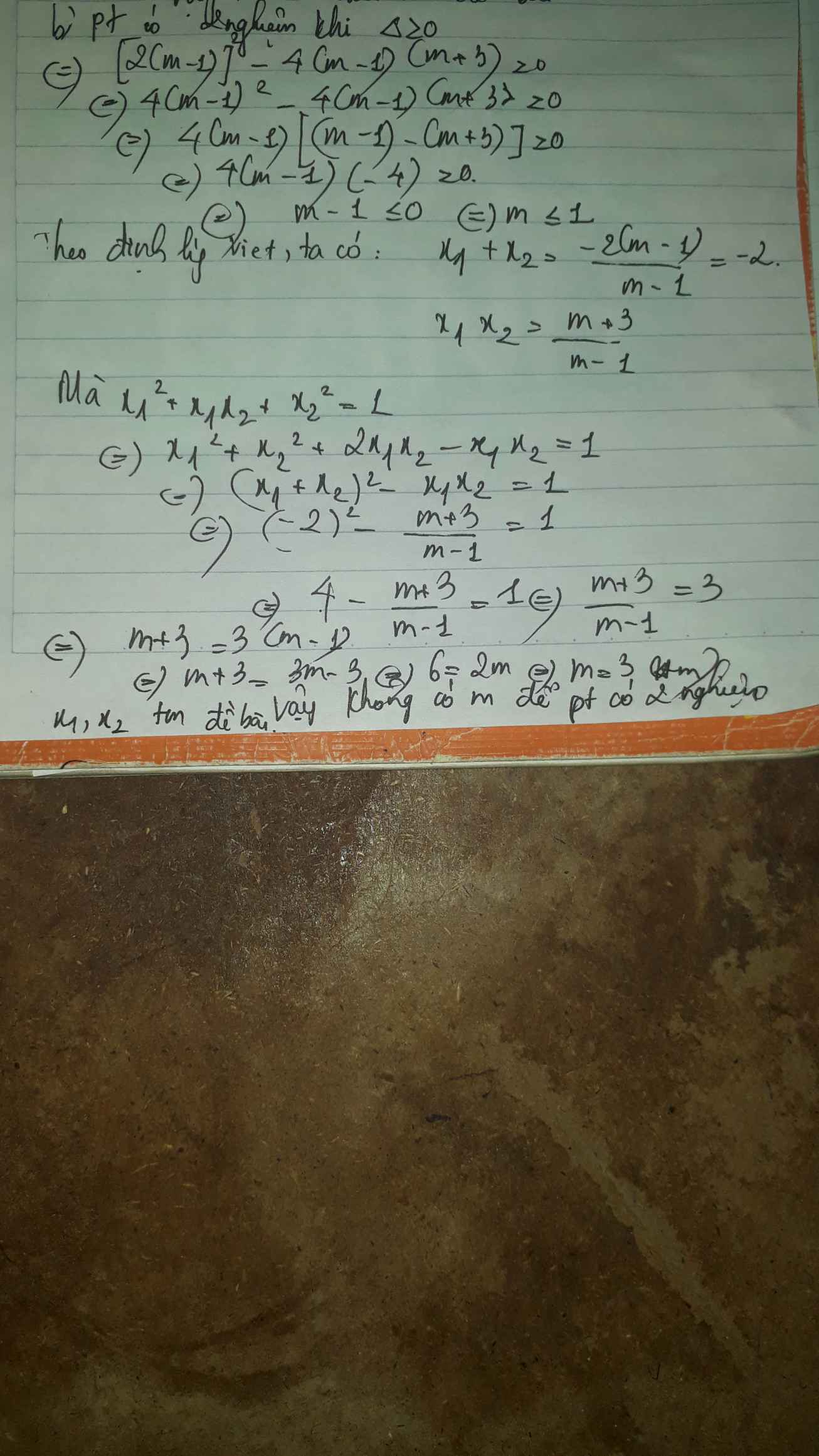Hãy nhập câu hỏi của bạn vào đây, nếu là tài khoản VIP, bạn sẽ được ưu tiên trả lời.

a. thay m=-4 vào (1) ta có:
\(x^2-5x-6=0\)
Δ=b\(^2\)-4ac= (-5)\(^2\) - 4.1.(-6)= 25 + 24= 49 > 0
\(\sqrt{\Delta}=\sqrt{49}=7\)
x\(_1\)=\(\dfrac{-b+\sqrt{\Delta}}{2a}=\dfrac{5+7}{2}\)=6
x\(_2\)=\(\dfrac{-b-\sqrt{\Delta}}{2a}=\dfrac{5-7}{2}\)=-1
vậy khi x=-4 thì pt đã cho có 2 nghiệm x\(_1\)=6; x\(_2\)=-1

a. Với m=6 thì phương trình (1) có dạng
x^2 - 5x +4= 0
<=> (x-1)(x-4)=0
<=> x=1 hoặc x=4
Vậy m=6 thì phương trình có nghiệm x=1 hoặc x=4
b. Xét \(\text{ Δ}=\left(-5\right)^2-4\cdot1\cdot\left(m-2\right)=33-4m\)
Để (1) có nghiệm phân biệt khi \(m< \dfrac{33}{4}\)
Theo Vi-et ta có: \(x_1x_2=m-2;x_1+x_2=5\)
Để 2 nghiệm phương trình (1) dương khi m>2
Ta có:
\(\dfrac{1}{\sqrt{x_1}}+\dfrac{1}{\sqrt{x_2}}=\dfrac{3}{2}\Leftrightarrow\dfrac{1}{x_1}+\dfrac{1}{x_2}+\dfrac{2}{\sqrt{x_1x_2}}=\dfrac{9}{4}\\ \Leftrightarrow\dfrac{x_1+x_2}{x_1x_2}+\dfrac{2}{\sqrt{x_1x_2}}=\dfrac{9}{4}\\ \Leftrightarrow\dfrac{5}{m-2}+\dfrac{2}{\sqrt{m-2}}=\dfrac{9}{4}\Leftrightarrow20+8\sqrt{m-2}=9\left(m-2\right)\\ \Leftrightarrow\left(\sqrt{m-2}-2\right)\left(9\sqrt{m-2}+10\right)=0\Leftrightarrow\sqrt{m-2}=2\Leftrightarrow m-2=4\Leftrightarrow m=6\left(t.m\right)\)

a, \(x^2-4x+3=0\Leftrightarrow x^2-x-3x+3=0\)
\(\Leftrightarrow x\left(x-1\right)-3\left(x-1\right)=0\Leftrightarrow\left(x-3\right)\left(x-1\right)=0\Leftrightarrow\orbr{\begin{cases}x=3\\x=1\end{cases}}\)
Vậy tập nghiệm của phương trình là S = { 1 ; 3 }
b, Ta có : \(\Delta=\left(2m+2\right)^2-4\left(2m-5\right)=4m^2+8m+4-8m+20=4m^2+24>0\forall m\)
Theo Vi et ta có : \(\hept{\begin{cases}x_1+x_2=-\frac{b}{a}=2m-2\\x_1x_2=\frac{c}{a}=2m-5\end{cases}}\)
Ta có : \(\left(x_1^2-2mx_1-x_2+2m-3\right)\left(x_2^2-2mx_2-x_1+2m-3\right)=19.1=1.19\)
TH1 : \(\hept{\begin{cases}x_1^2-2mx_1-x_2+2m-3=19\\x_2^2-2mx_2-x_1+2m-3=1\end{cases}}\)
Lấy phương trình (1) + (2) ta được :
\(x_1^2+x_2^2-2mx_1-2mx_2-x_2-x_1+4m-6=20\)
mà \(\left(x_1+x_2\right)^2=4m^2+8m+4\Rightarrow x_1^2+x_2^2=4m^2+8m+4-2x_1x_2\)
\(=4m^2+8m+4-2\left(2m-5\right)=4m^2+4m-6\)
\(\Leftrightarrow4m^2+4m-6-2m\left(2m-2\right)-\left(2m-2\right)+4m-6=20\)
\(\Leftrightarrow4m^2+4m-6-4m^2+4m-2m+2+4m-6=20\)
\(\Leftrightarrow10m=30\Leftrightarrow m=3\)tương tự với TH2, nhưng em ko chắc lắm vì dạng này em chưa làm bao giờ

b) phương trình có 2 nghiệm \(\Leftrightarrow\Delta'\ge0\)
\(\Leftrightarrow\left(m-1\right)^2-\left(m-1\right)\left(m+3\right)\ge0\)
\(\Leftrightarrow m^2-2m+1-m^2-3m+m+3\ge0\)
\(\Leftrightarrow-4m+4\ge0\)
\(\Leftrightarrow m\le1\)
Ta có: \(x_1^2+x_1x_2+x_2^2=1\)
\(\Leftrightarrow\left(x_1+x_2\right)^2-2x_1x_2=1\)
Theo viet: \(\left\{{}\begin{matrix}x_1+x_2=-\dfrac{b}{a}=2\left(m-1\right)\\x_1x_2=\dfrac{c}{a}=m+3\end{matrix}\right.\)
\(\Leftrightarrow\left[-2\left(m-1\right)^2\right]-2\left(m+3\right)=1\)
\(\Leftrightarrow4m^2-8m+4-2m-6-1=0\)
\(\Leftrightarrow4m^2-10m-3=0\)
\(\Leftrightarrow\left[{}\begin{matrix}m_1=\dfrac{5+\sqrt{37}}{4}\left(ktm\right)\\m_2=\dfrac{5-\sqrt{37}}{4}\left(tm\right)\end{matrix}\right.\Rightarrow m=\dfrac{5-\sqrt{37}}{4}\)

\(x^2-\left(m+1\right)x+m+4=0\left(1\right)\)
\(\Rightarrow\Delta>0\Leftrightarrow\left(m+1\right)^2-4\left(m+4\right)>0\Leftrightarrow\left[{}\begin{matrix}m< -3\\m>5\end{matrix}\right.\)\(\left(2\right)\)
\(ddkt-thỏa:\sqrt{x1}+\sqrt{x2}=2\sqrt{3}\)
\(x1=0\Rightarrow\left(1\right)\Leftrightarrow m=-4\Rightarrow\left(1\right)\Leftrightarrow x^2+3x=0\Leftrightarrow\left[{}\begin{matrix}x1=0\\x2=-3< 0\left(loại\right)\end{matrix}\right.\)
\(x1\ne0\) \(\Rightarrow0< x1< x2\)
\(\Leftrightarrow\left\{{}\begin{matrix}x1+x2>0\\x1x2>0\end{matrix}\right.\Leftrightarrow\left\{{}\begin{matrix}m+1>0\\m+4>0\end{matrix}\right.\)\(\Rightarrow m>-1\)\(\left(3\right)\)
\(\left(2\right)\left(3\right)\Rightarrow m>5\)
\(\Rightarrow\sqrt{x1}+\sqrt{x2}=2\sqrt{3}\)
\(\Leftrightarrow x1+x2+2\sqrt{x1x2}=12\Leftrightarrow m+1+2\sqrt{m+4}=12\)
\(\Leftrightarrow m+4+2\sqrt{m+4}-15=0\)
\(đặt:\sqrt{m+4}=t>5\Rightarrow t^2+2t-15=0\Leftrightarrow\left[{}\begin{matrix}t=-5\left(ktm\right)\\t=3\left(ktm\right)\end{matrix}\right.\)
\(\Rightarrow m\in\phi\)
Để pt có 2 nghiệm pb
\(\left(m+1\right)^2-4\left(m+4\right)=m^2+2m+1-4m-16\)
\(=m^2-2m-15>0\)
Theo Vi et \(\left\{{}\begin{matrix}x_1+x_2=m+1\\x_1x_2=m+4\end{matrix}\right.\)
Ta có : \(\left(\sqrt{x_1}+\sqrt{x_2}\right)^2=12\Leftrightarrow x_1+2\sqrt{x_1x_2}+x_2=12\)
Thay vào ta được \(m+1+2\sqrt{m+4}=12\Leftrightarrow2\sqrt{m+4}=11-m\)đk : m >= -4
\(\Leftrightarrow4\left(m+4\right)=121-22m+m^2\Leftrightarrow m^2-26m+105=0\)
\(\Leftrightarrow m=21\left(ktm\right);m=5\left(ktm\right)\)

Δ=(2m-2)^2-4(m-3)
=4m^2-8m+4-4m+12
=4m^2-12m+16
=4m^2-12m+9+7=(2m-3)^2+7>=7>0 với mọi m
=>Phương trình luôn có hai nghiệm phân biệt
\(\left(\dfrac{1}{x1}-\dfrac{1}{x2}\right)^2=\dfrac{\sqrt{11}}{2}\)
=>\(\dfrac{1}{x_1^2}+\dfrac{1}{x_2^2}-\dfrac{2}{x_1x_2}=\dfrac{\sqrt{11}}{2}\)
=>\(\dfrac{\left(\left(x_1+x_2\right)^2-2x_1x_2\right)}{\left(x_1\cdot x_2\right)^2}-\dfrac{2}{x_1\cdot x_2}=\dfrac{\sqrt{11}}{2}\)
=>\(\dfrac{\left(2m-2\right)^2-2\left(m-3\right)}{\left(-m+3\right)^2}-\dfrac{2}{-m+3}=\dfrac{\sqrt{11}}{2}\)
=>\(\dfrac{4m^2-8m+4-2m+6}{\left(m-3\right)^2}+\dfrac{2}{m-3}=\dfrac{\sqrt{11}}{2}\)
=>\(\dfrac{4m^2-10m+10+2m-6}{\left(m-3\right)^2}=\dfrac{\sqrt{11}}{2}\)
=>\(\sqrt{11}\left(m-3\right)^2=2\left(4m^2-8m+4\right)\)
=>\(\sqrt{11}\left(m-3\right)^2=2\left(2m-2\right)^2\)
=>\(\Leftrightarrow\left(\dfrac{m-3}{2m-2}\right)^2=\dfrac{2}{\sqrt{11}}\)
=>\(\left[{}\begin{matrix}\dfrac{m-3}{2m-2}=\sqrt{\dfrac{2}{\sqrt{11}}}\\\dfrac{m-3}{2m-2}=-\sqrt{\dfrac{2}{\sqrt{11}}}\end{matrix}\right.\)
mà m nguyên
nên \(m\in\varnothing\)

\(x^2-2\left(m+4\right)x+m^2+8m-9=0\left(1\right)\)
Ta giải \(\Delta=[-2\left(m+4\right)]^2-4\left(m^2+8m-9\right)=100>0\forall m\)
suy ra pt có 2 nghiệm phân biệt \(x_1,x_2\forall m\).
Ta có: \(x_1=m-1\), \(x_2=m+1\) (thay \(\Delta\) vào công thức tìm nghiệm phân biệt).
Gọi \(A=\dfrac{x_1^2+x_2^2-48}{x_1^2+x_2^2}\).
\(\Rightarrow A=1-\dfrac{48}{x_1^2+x_2^2}=1-\dfrac{48}{\left(m-1\right)^2+\left(m+1\right)^2}=1-\dfrac{24}{m^2+1}\).
Để biểu thức A nguyên thì \(\dfrac{24}{m^2+1}\) nguyên, suy ra \(m^2+1\inƯ\left(24\right)\).
\(\Rightarrow m^2+1\in\left\{1;2;4;6;8;12;24\right\}\)
\(\Rightarrow m\in\left\{0;\pm1\right\}\) (vì m nhận giá trị nguyên)
Vậy \(m\in\left\{0;\pm1\right\}\) là giá trị cần tìm.
Mình chỉnh sửa lại một chút nhé.
\(A=1-\dfrac{24}{m^2+2}\)
\(\Rightarrow...\)\(\Rightarrow\)\(m^2+2\in\left\{1;2;3;4;6;8;12;24\right\}\)
\(\Rightarrow m\in\left\{0;\pm1;\pm2\right\}\)
Vậy...

a) Thay m = -12 vào phương trình (1), ta được:
x² - 5x - 12 - 2 = 0
x² - 5x - 14 = 0
Ta có thể phân tích phương trình trên như sau:
x² - 7x + 2x - 14 = 0
x(x - 7) + 2(x - 7) = 0
(x - 7)(x + 2) = 0
Vậy, phương trình có hai nghiệm: x₁ = 7
x₂ = -2
Để phương trình (1) có hai nghiệm phân biệt x₁, x₂, điều kiện là Δ > 0, trong đó Δ là biệt thức của phương trình bậc hai.
Δ = b² - 4ac = (-5)² - 4(1)(m - 2) = 25 - 4m + 8 = 33 - 4m
Để phương trình có hai nghiệm phân biệt, ta cần:
33 - 4m > 0
4m < 33
m < 33/4
Theo hệ thức Viète, ta có:
x₁ + x₂ = -b/a = 5
x₁x₂ = c/a = m - 2
Theo đề bài, ta có:
2(1/x₁ + 1/x₂) = 3
2(x₂ + x₁)/(x₁x₂) = 3
2(5)/(m - 2) = 3
10 = 3(m - 2)
10 = 3m - 6
3m = 16
m = 16/3